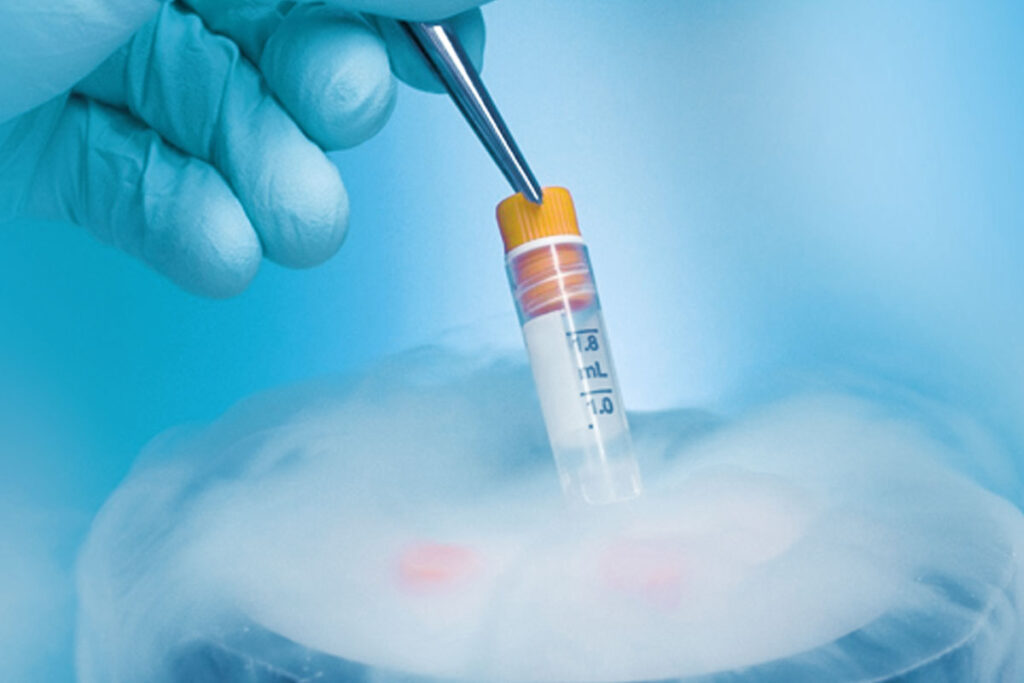Frozen embryo transfer (FET) is an IVF procedure in which a cryopreserved embryo generated during an entire IVF cycle is thawed and transferred to the uterus.
A couple’s “spare” embryos from a prior conventional IVF round are frequently used in FET. A donor embryo can also be a cryopreserved embryo.
IVF hospital offers elective frozen embryo transfer when a fresh transfer is not possible (sometimes known as a “freeze all” technique). All embryos are cryopreserved in this circumstance and will be transplanted in a FET cycle in the following month.
How Are Embryos Frozen?
According to the infertility specialists in India, Vitrification, a quick flash-freezing process, is used to freeze embryos. The embryos are treated with cryoprotectants during this procedure, which assists protect the cells during the freezing and subsequent thawing operations. The embryos are then rapidly frozen, preventing water molecules from crystallizing into ice crystals. The end product is a glass-like structure that can remain in a frozen state indefinitely.
What are the Benefits of Frozen Embryo Transfer?
One of the most common reasons people opt for frozen embryo transfer is that they wish to have multiple children but only have one round of IVF. In this case, the woman goes through IVF as usual, then has a fresh embryo transfer while the rest of the embryos are frozen. When she is ready to start a family, she will already have a batch of frozen embryos on hand and will be able to skip the first round of IVF.
However, some people are opting for frozen embryo transfer instead of fresh embryo transfer. The main advantage of frozen embryo transfer is that you can postpone implantation until your hormones have recovered from the IVF procedure.
Fertility medicines are used in IVF to stimulate the ovaries, resulting in higher estrogen levels than seen in a regular monthly cycle. The production of estrogen induces ovulation and the creation of another hormone called progesterone, which prepares the endometrial lining of the uterus for implantation in a regular menstrual cycle. In IVF, however, the artificially raised estrogen level might sometimes cause the progesterone level to rise too quickly.
As a result, the endometrial lining can develop before the embryo can be implanted, making it difficult for the embryo to properly connect to the uterine wall. However, when you use frozen embryo transfer, you can postpone implantation until a later cycle when your progesterone level can be better timed, increasing your chances of successful embryo implantation.
How Does IVF Work With Frozen Embryo Transfer?
We can avoid desynchronization by using FET and delaying embryo transfer until a later cycle allows your hormones to return to normal before starting, which may improve your chances of becoming pregnant. Embryos are generated and frozen rather than implanted while the body is still healing from IVF. The embryos are frozen and implanted once the body has recovered from the stress of IVF and has returned to a more regular cycle.
Families who want to choose the gender of their kids can also employ this method. They may do so to guarantee that both sexes are represented equally or for any other purpose. Embryos are generated, biopsied, tested, and frozen during the first cycle. Once the biopsy findings have been received, and the female partner has healed from her egg retrieval, an embryo transfer will be scheduled.
What is the FET Success Rate in IVF?
The doctors from the Nisha IVF hospital in Ahmedabad believe that freezing techniques like vitrification have evolved dramatically in recent years to resemble spontaneous conception, resulting in higher pregnancy and live birth rates, fewer miscarriages, and healthier kids. The sophisticated vitrification procedure utilized at IVF hospital significantly reduces loss rates compared to the older slow freezing technique, which delivered few viable embryos.
Dangers
In comparison to a complete IVF cycle, a frozen embryo transfer cycle carries far fewer hazards. Ovarian hyperstimulation syndrome is one of the most severe side effects of IVF (and fertility medications) (OHSS). In a FET cycle, however, you won’t have to worry about OHSS because ovarian stimulating medicines aren’t employed.
There are dangers associated with embryo transfer, including an increased chance of ectopic pregnancy and a minor risk of infection. Multiple pregnancies may be more likely depending on how many embryos are transferred (which comes with its own set of chances for a pregnant person and the fetuses they are carrying).
Many embryos will survive the freeze-thaw process thanks to cryopreservation. The embryo can be re-biopsied if the PGT testing results are inconclusive (it’s uncertain if it’s normal or not). The success rate drops slightly as a result of this, but not dramatically.
When embryos are frozen, thawed, and re-biopsied, and refrozen, there is a danger of losing them or having a decreased success rate when melting for use. However, this does not always imply that a fresh transfer is the best option.
The doctors from the Nisha IVF hospital in Ahmedabad states that there is a chance that kids delivered from frozen embryo transfers will be “big for gestational age.” However, a meta-analysis indicated that frozen embryo transfers might result in healthier pregnancies and newborns than fresh embryo transfers. Frozen embryo transfer kids had a decreased risk of preterm birth, stillbirth, and low birth weight, according to the study.
Another study looked at the odds of congenital disabilities in children born by fresh IVF, frozen embryo transfers, and naturally conceived infants. When compared to spontaneously conceived infants, children who received new IVF transfers were three times more likely to suffer a congenital disability. With frozen embryo transfer, however, this increased risk was not observed (perhaps because these frozen embryos could have been tested with PGT). Overall, the risk of birth abnormalities remained relatively low.
Also, Read This: IVF Treatment In India FAQ
